
Consumers in the US are now faced with expanding options for fresh food purchases as non-grocery retailers look to capture a share of fresh food sales from supermarkets, according to a recent report by The Perishables Group, a Chicago-based consulting firm.
Supermarkets have historically been the primary location where consumers could purchase their fresh food items, the report said, while convenience stores and big box stores usually offered an assortment of packaged, non-perishables items; their selection of meats, produce, baked goods and other fresh items were, at best, secluded in small kiosks with limited selection and quality.
But changing consumer shopping habits, particularly the consolidation of shopping trips in an effort to save money on gas during the economic downturn, have prompted retailers to shift their trading practices by offering fresh food on their shelves.
Walmart is likely the most notable channel conquering a share of perishables sales, the report found. The company recently reported that grocery sales, including improvements in the perishables offering, showed gains during the second quarter.
Target is also making efforts to remain competitive with the retail giant, with its new store layout, P-fresh, featuring extra floor space devoted to fresh produce, meat and bakery items
Some consumers, meanwhile, are choosing convenience over cost savings as convenience stores increase their share of shoppers, according to Convenience Store News. And although newer to the fresh food scene than convenience stores, drug stores are also beginning to gain ground and establish themselves as one-stop-shops for consumers.
According to data compiled by Nielsen, the percentage of US households shopping in drug stores decreased from 89 per cent to 81 per cent in the past decade; yet eight of the 11 categories with the strongest growth are food categories.
Furthermore, drug store giant Walgreens hired a former Tesco Fresh & Easy executive as its new vice-president of format development at the end of last year to focus on food and other consumables.
Carrying fresh food offerings has even stretched as far as dollar stores and kid-focused retailers, The Perishables Group said. As of last May, Family Dollar Stores expanded space allotted for food and consumer products, while Toys “R” Us re-merchandised some stores to include beverages, snacks and cereals.
Retailers may have reason to be concerned by competition from other channels, but The Perishables Group claimed they can still claim an advantage for those consumers who want to save time with a quick grocery run or want access to a complete line of fresh products.
“The key to supermarkets maintaining their status as the go-to location for fresh food purchases will be to know their consumers, and to use that knowledge to offer the items their consumers want or may not be able to get elsewhere at the optimal price or level ofquality,” the report concluded.



